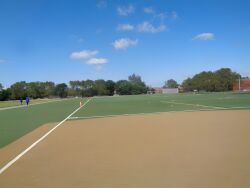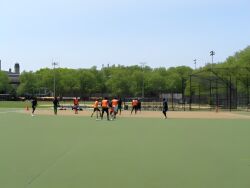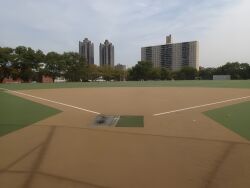Harris Park
Harris Field
Father John Joseph Harris (1884-1937) dedicated much of his life to working with youth. A native of Yonkers, Father Harris first entered the novitiate in 1911 at Villanova, Pennsylvania and was ordained to the priesthood seven years later. From 1919 to 1935 he was stationed at St. Rita’s High School in Chicago where he served as Prior, President, and Procurator. Father Harris joined St. Nicholas of Tolentine Church on University Avenue in 1935. He served as Prior there until his death from a heart attack on June 8, 1937 while on field trip with a group of children at Bear Mountain State Park. Though Harris’s sojourn in the borough was brief, he left such a strong impression in the Bronx that the City Council named this park in his honor in 1940.
Harris Field and many of the facilities and institutions of Jerome Park share the same origins. In the 19th century the area formed part of Andrew Bathgate’s estate. It was later purchased by Leonard Walter Jerome, who operated the Jerome Park Racetrack there from 1866 to 1889. Jerome was the maternal grandfather of Winston Churchill. In 1895 the Department of Water Supply, Gas & Electricity acquired land for the Jerome Park Reservoir, which was first filled in 1905 with a capacity of 773,000,000 gallons of water. The east basin was to have had a capacity twice that of the west basin. It was planned to have the boundaries of Jerome Avenue, West Kingsbridge Road, and Mosholu Parkway. The pit was abandoned and filled in 1912, and returned to the city in 1917.
Harris Park was acquired by Parks in 1940. Labor provided by the Federal Work Projects Administration developed the site as an athletic facility. There were four baseball diamonds, two softball diamonds, fields for football and other sports, and a sitting area. In 1961 the fieldhouse, with its lockers, bathrooms, and showers, was opened. The park’s neighbors include Lehman College to the south (originally built as Hunter College Uptown in 1932), the Bronx High School of Science to the north (relocated here in 1958), and the subway yards of the Lexington Avenue Line of the Interborough Rapid Transit, which opened in 1917.
A $555,000 renovation funded by Council Member June M. Eisland was completed in 1997. Additions to the playground include new asphalt paving, fences, benches, trees, picnic tables, and a water supply system. The ballfields, the central feature of the park, were reconstructed and resodded with new turf.
Check out your park's Vital Signs
Clean & Safe
Green & Resilient
Empowered & Engaged Users
Share your feedback or learn more about how this park is part of a
Vital Park System








